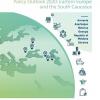News
Displaying Results 26 - 50 of 53
Since its independence, Armenia has been one of the fastest-growing economies among the countries in Eastern Europe and South Caucasus (EESC) with GDP growth averaging 6 percent during the last two decades. Fueled by substantial reforms and increased foreign investment, the country embarked on a…
Transitioning towards a knowledge-based economy away from a resource-intensive model of economic growth is central for sustainable development among the seven countries of the UN Special Programme for the Economies of Central Asia (SPECA) - Afghanistan, Azerbaijan, Kazakhstan, Kyrgyzstan,…
As world leaders gather in Glasgow for COP 26, there is increasing recognition that the transition to renewable energy is vital to tackle climate change. The circular economy aims at sustainable production, consumption and resource use by minimizing pollution, turning waste products into productive…
Since their independence, countries in Eastern Europe and the South Caucasus (EESC) – Armenia, Azerbaijan, Belarus, Georgia, the Republic of Moldova and Ukraine – have introduced far-reaching reforms to boost innovation and benefit from the potential of the growing knowledge-based economy.…
UNECE is deepening its support to help countries of the region capitalize on innovation to recover from the pandemic and realize the ambitious vision of the 2030 Agenda.
The UNECE Innovation for Sustainable Development Review (I4SDR) of Uzbekistan, which is currently underway, will set out…
Migration is an old and growing phenomenon – the United Nations Populations Division estimates that around 266 million people live outside their country of origin. In the UNECE region, by 2019 there were around 45 million people from Eastern Europe and Central Asia living abroad, with more than…
Both innovation and Public-Private Partnerships (PPPs) are essential drivers of economic development, environmental sustainability and social inclusiveness.
The UNECE region was hit hard by the COVID-19 crisis, not only because of the health crisis itself but also, even as the threat recedes…
Innovation has huge potential to drive sustainable development if supported by a vibrant innovation ecosystem. This requires effective linkages and collaboration at national level, and an innovation culture nurtured by a system of support to start ups and institutions such as business incubators.…
A small sub-set of small- and medium-sized enterprises – innovative, high-growth enterprises (IHGEs) – play an outsize role in innovation and structural transformation across the world. They spearhead experimentation with new ideas to create value, address challenges, and reduce transaction costs…
The countries of Eastern Europe and the South Caucasus (the EESC sub-region), Armenia, Azerbaijan, Belarus, Georgia, the Republic of Moldova and Ukraine have come a long way in their transition from centrally planned towards market-based economies. After a difficult first decade following…
The COVID-19 pandemic has hit the economy hard. Global GDP is estimated to have fallen by 3.5 in 2020, and even more steeply in parts of the UNECE region. International trade has been disrupted. Progress towards the UN Sustainable Development Goals has slowed down at a time when it would be…
Uzbekistan has shown remarkable growth in its transition from a centrally planned to a market based economy, with annual growth rates between 5 and 9 per cent since 2004. Innovation, namely fostering experimentation and collaboration between innovation stakeholders to find new ways for creating…
Innovation is central to build back better after the COVID-19 pandemic and to drive sustainable development. Making up over 10% of Gross Domestic Product globally, public procurement carries the potential to stimulate broad experimentation with new ideas and technologies to attain economic, social…
Digital platforms have the potential to transform society fundamentally – creating new opportunities for economic growth and unlocking benefits in terms of poverty reduction on the one hand, and environmental sustainability on the other. They could help support less resource-intensive consumption…
A small group of innovative, high-growth enterprises, representing 2 to 6 per cent of the business population, plays a disproportionately large role in innovation, structural change, and sustainable development more broadly. Their potential as drivers of experimentation with the ideas needed to…
The countries of the UN Special Programme for the Economies of Central Asia (SPECA) - Afghanistan, Azerbaijan, Kazakhstan, Kyrgyzstan, Tajikistan, Turkmenistan and Uzbekistan - gathered for a virtual session of the SPECA Working Group on Innovation and Technology for Sustainable Development (WG on…
Representatives from the six countries in Eastern Europe and South Caucasus (EESC) and international experts met to discuss the preliminary results and recommendations of UNECE’s Subregional Innovation Policy Outlook (IPO) at the second meeting of the IPO national focal points, this week in…
The world is urbanizing fast. Already today, half the population is living in cities. By 2050, that proportion is projected to rise to over two thirds. Cities are economic powerhouses, accounting for 80 percent of world GDP. They also have large ecological footprints, accounting for 60-80 percent…
On the occasion of the second session of the Working Party on Public Private Partnerships (PPPs), held in Geneva on 20-21 November 2018, UNECE launched the International PPP Dialogue for Belt and Road (BRI) countries. The session was organized under the auspices of the Memorandum of Understanding…
In a rapidly changing global and regional economy, a systematic approach to national technology and innovation foresight system is a central element to inform, monitor, and evaluate national science, technology and innovation strategies – ensuring that they contribute towards sustainable…
The world economy is set to transform in ways that are as radical as they are unpredictable, changing the ways we produce and consume goods and services. The Fourth Industrial Revolution, also known as Industry 4.0, brings myriad new possibilities to use emerging physical, digital, and biological…
A critical challenge to overcome in achieving the Sustainable Development Goals (SDGs) is the lack of women - top to bottom - in business: this is well documented (according to a FTSE 100 report on UK public companies, the number of male CEOs named ‘David’ is larger than the number of women CEOs…
A circular economy is one that designs most pollution and waste out of the system, extracts maximum value from resources and allows natural capital to regenerate. This would not only protect the environment, but also contribute to economic growth, increasing GDP by up to 7% in the EU by 2030 -…
Advancing progress towards Sustainable Development Goal 12 on sustainable consumption and production is pivotal to sustainable development. Consuming and producing more sustainably – doing more and better with less – contributes to socially and environmentally responsible development in multiple…
The Government of Kyrgyzstan has stressed the necessity to enhance its national innovation system as one of the priorities of its National Sustainable Development Strategy for the period 2013-2017. The strategy has highlighted the need to strengthen linkages between, on the one hand, the…











